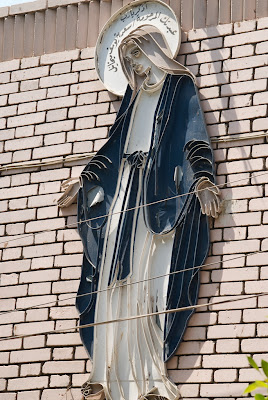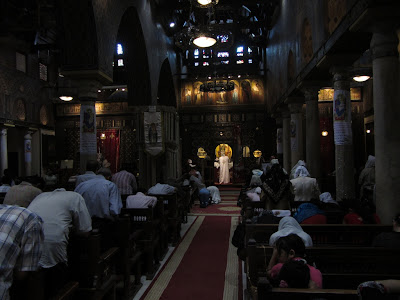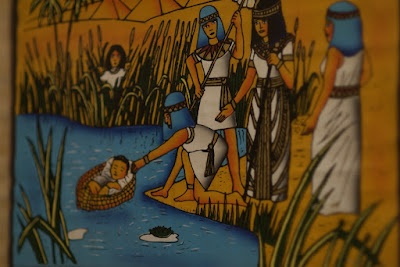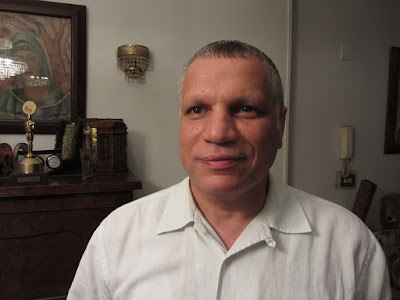George Kyrillos leads David Ensemble, a group specializing in performing hymns from the liturgy of the Coptic Christian Church in Egypt, and in composing music for the Psamls of David. He is a scholar, an accomplished musician, and a fine singer. He also curates a fantastic website, http://www.davidensemble.com/, rich in audio and video. Visit the Multimedia section there to hear and download music. Afropop’s Banning Eyre visited George at his home in the Maadi neighborhood of Cairo in August, 2011. They spoke without an interpreter, in English—not a language George speaks often, but he did well. Here’s an edited transcript of their conversation.
B.E.: Thank you very much first of all for doing this. I really appreciate your talking to us about Coptic music, a new subject for us absolutely. So, why don’t you start by just introducing yourself?
G.K.: My name is George Kirillos. I am 55 years old. I have a background studying music. I have a bachelor’s in music and high diploma in conducting orchestra from the Academy of Arts in Egypt. Really, despite my engineering studies background, Coptic hymns are something that has affected me very much since I was a very young boy. I believe since I was five years old I had the impression that Coptic hymns is something that can touch my feelings, my spiritual…
B.E.: Your soul.
G.K.: Yes, my soul. And because of that I decided to study music, to know what’s behind this Coptic music. And because of that also I established David Ensemble. It’s a group established in 1975, so about 36 years ago. My aim at that time was to preserve the psalms of David because, you know, some of David’s melodies, most of them, have been lost. We have only the texts. So I put on my shoulder to composing new melodies for these Psalms with the same spirit of the Coptic hymns. So, it will be Egyptian in nature. This is one of my targets, and the other target is to introduce the Coptic hymns for the people in an understanding way. Because sometimes the way we are trying to, while we are praising God by these Coptic hymns, it’s not good, sometimes we like [SINGS POORLY] something like that, it’s not good. So I wanted to introduce these Coptic hymns for the people in a good way, in a good performance.
B.E.: Expressing their full beauty.
G.K.: Yes, and this was my target. If you ask me, “Why are you fascinated with Coptic hymns?” I’ll tell you that Coptic hymns are the only hymns in the world that have existed since 2,000 years ago. If you have any example for any type of music existing these thousands of years, please tell me because I would love it also. Because the hymns when they have stayed for these long years it become like the Pyramids. You know, the effect of the years, no one can deny it.

B.E.: Two thousand years. That is inspiring.
G.K.: Yes, and the problem is when we speak about two thousand years ago, there was no multimedia like now, no recording media, no cassette, no CD, DVD, all these media have been introduced only a hundred years ago.
B.E.: A very short time in the eyes of history.
G.K.: Yes, so it was a challenge for the Coptic Church to preserve 1,048 hymns for this long time without any music notation or without recording media. Because, you know, music notation has been established in the 11th Century. The Coptic Church selects cantors, and they prefer to select blind cantors, because when the person is blind he can remember these hymns very well. Because really when you speak about 1,000, around 1,000, hymns he has to preserve it in his mind and his heart. And to remember some of them that are used only once a year—it is very difficult. And the hymn might be twenty minutes long, and a very sophisticated hymn, not an easy hymn. [SINGS A BEAUTIFUL, ORNAMENTED LINE] And then, twenty minutes like that, so it’s not easy for the cantor to remember such details of melody.
B.E.: Very difficult, so a hymn like that IS two thousand years old and it’s been preserved by oral tradition by elders singing it to younger singers, singers learning it, growing up, singing it to younger singers over and over like this. And the melody that you’re singing now, that you just sang, it really comes from all the way back then? That’s inspiring to think of. Two thousand years old.
G.K.: Yes.
B.E.: And do you believe that that music has been changed at all in this process, or do you think that it has stayed pretty true to what it was?
G.K.: We have to remember two items. For this music to be changed completely, that will not happen, because it’s preserved in the Coptic Church. But if we can say that this music is absolutely solid, without any emotions without any effects, without any influences from the outside, that also never happened. Because if it’s like that, that means what we have now is very tough and very solid. But it’s alive, this music. I mean, it has been affected by all people who have been praising these songs during these thousands of years. But without changes, I mean that… You know the Sphinx?
B.E.: Sure.
G.K.: The Sphinx, yes.

It stands there for seven thousand years, that’s ok? But it is the same or changed? If we say, “No, it’s completely changed,” that’s not right because it’s the Sphinx. And if we say it is the same, exactly, no. Because the years affect the Sphinx. It has now become different than it was thousands of years ago. You got my point?
B.E.: Yes.
G.K.: So the Coptic liturgy is the same. It’s not completely changed because the Coptic church preserved these hymns inside its liturgy and inside its rituals. But at the same time, it’s not completely solid because each one who sings these hymns gives his spirit, gives his emotions. And sometimes he adds some ornaments, very small ornaments, these ornaments may be to give these hymns more emotional effect. So we can’t say that it’s completely changed and we can’t say that it’s not changed completely. It’s something in between.
B.E.: Very nice.
G.K.: Really some of these Coptic hymns have Pharonic roots. Because as I said it’s a long time ago, and the oldest hymns were composed by our early fathers. Some of these hymns, like Eporo were sung in the ceremonies for the Pharaoh. Eporo means “king” as in king of the peace. These words of the hymn are very wonderful. It has many forms in the church, one to be used in the feast, another to be used in the holy week, and another to be used in the midnight praising. Each one has a different melody and has a different mood and the first one [SINGS] it’s different then the second one [SINGS]. It’s completely different, according to the mood the church wants to praise in.
Hear recordings of all three "Eporo" versions here.
Hear or download the 1995 Paris concert that includes Eporo.
B.E.: So the first one you sang was the one that would be at festivals or weddings?
G.K.: It says, “Of joy and of feasts and of weddings.”
B.E.: Ok, and the second one is the one of the midnight prayer.
G.K.: Yes. And the third one has the melody of grief in the holy week. This is for the midnight [SINGS].
B.E.: You can hear in those melodies that it’s very old music. It’s beautiful.
G.K.: When we speak about Coptic hymns we have to remember some musical items. The first one is the huge number of scales, musical scales, of these Coptic hymns. You can find these hymns, in the same hymns he can change the scale many times. Sometimes in one Coptic hymn, you can find two or three or four musical scales. And you know that when the people can transfer from one mood to the other mood, from one scale to another to the third to the fourth. That means these people are professional, they are not just wanting to praise God and using any melody—no, no. They are talented for sure and they are also big composers, they are educated and know the scales and know they way to transfer from one scale to another.
B.E.: That’s interesting. You said many different scales; are all of those scales derived from the twelve-note chromatic scale that you’d find on a piano or are there any microtones in those scales?
G.K.: Some of these scales are major scales, but sometimes you can find Saba scale

B.E.: You mean the maqam [Arabic mode]?
G.K.: Yes. Maqam Saba is with microtone. [SINGS]. It’s Saba. And for many hymns, you can find many, hundreds, of maqams, different from one to another. And in the same hymn you can find a lot of maqams, sometimes two or three or more. This first item is the scale. The second item is the rhythm. In Coptic music, you can find 3/4, 4/4, and 2/4. And then the one without any regular rules, any measures
B.E.: No rhythm, per se.
G.K.: No rhythm. The maestro cannot use his hand to lead the orchestra or the choir with this.
B.E.: So it’s like mawal in Arabic music.
G.K.: Like Mawai, that’s a good example. And if you ask me why we have many sounds, many hundreds of scales, music scales. That means that it’s a rich music, but in rhythms, there are very few. Why? I said that when we talk about rhythm, you are talking about the body, you know? Rhythm can move the body; our church does not deal with the body, it deals with the soul, with the spirit. That when we use the rhythm, that means that we need a person to move his body and by the end of the hymns they can dance. Our church is traditional and they don’t like to dance or to move the body, it needs to move the soul. And because of that, they use the scales, many scales, but very few rhythms.

B.E.: So, many scales, few rhythms.
G.K.: Yes and many ornaments.
B.E.: Talk about ornaments.
G.K.: Ornaments. You know that in Pharonic styles, like the old painting of the temples, you’ll find many ornaments. These ornaments are in the nature of Egypt, and because of that, our Coptic hymns are also affected by the ornaments. So you can find in our Coptic hymns many ornaments. If you see that [SINGS]. All these ornaments are just to give you the feeling of the word Halleluiah.
B.E.: Adding that extra bit of beauty. Yeah, that’s nice. And when you perform these, I heard from the bit that I heard of the David Ensemble, your backing instrumentation, you have something like an orchestra. You have violins; tell me something about the instrumental and musical backing.
G.K.: Yes. When you speak about Coptic hymns in the church, in the liturgy, you can’t speak about instruments. These items have been removed from our Coptic hymns, from our Coptic Church. The instruments, except the cymbals and the triangle, just to adapt to the rhythm, when we have rhythm, or to give a matter of joy, something like that. Instruments have been removed except those. The dance? There is no dance. And statues. We didn’t have statues.
B.E.: So you don’t have statues of Jesus like you would find in a European Christian church.
G.K.: No, you can’t have them. You can find it in other churches, but not in Orthodox Coptic church, you will not find it. And this is because in the early days of Christianity in Egypt, the Church wanted to make a difference between singing and praising in the temple and in the church. They are in the temple using dance, so they cancelled the dancing here. They used statues, and in Coptic Church they cancelled these statues. Just to… we can’t say haram. You know haram, forbidden. It’s not like that. It’s because we have to make a difference. When you go to this temple, you will find dancing. But not in the church.
B.E.: Give us the sense of the age and dimensions of the Coptic liturgy.
G.K.: So, we spoke about the scales, the rhythms, the ornaments. Now we can speak about how the church makes these rituals not boring. We have about 35 rituals in the Coptic Church. The problem is that some of the rituals, like Holy Friday, people spend 10 hours a day in the church listening to Coptic hymns. So the Church has tried to make it very attractive, to make the ritual not boring. When you go to an opera, you will go for 1 or 2 hours maximum. But in the Coptic, orthodox church, you will spend about 10 hours listening to Coptic hymns. How? There are many items: One, the church varies the duration of the hymns. Some of the hymns will be 3 seconds, some longer, about 4 minutes. Sometimes even longer. And so on.
Hear the David Ensemble performing the hymn "Erepo Esmo."
Hear or download the entire Hymns of Basilius mass.
B.E.: In that 10 hours, does the congregation know the songs? Do they sing along? How do they participate?
G.K.: The first item is to change the duration of the Coptic hymns. Then the congregation will respond because the Coptic Church uses 4 types of performers. There is antiphonal singing. They used to have 2 groups of deacons to praise God. This gives a different sound because one comes from here, and sound also comes from there. Another type of singing is call and response. The deacon or priest will sing, and the whole congregation will respond. Like saying amen or halleluiah. He will say something and they will say Amen. [SINGS].

B.E.: And they know these melodies? They are not written down?
G.K.: Yes. It’s studied by repetition. They change the duration and performance by these 4 types: antiphonal, response, and also solo. The priest or cantor will sing alone. This type of hymn that has been used for solo singing; it has been designed for that. Such type of hymn cannot be by a group. It is designed for one singer. This is the third type of singing. The fourth one is for a group, for a congregation, for the people that are in the church to pray. The whole congregation will sing this hymn as one unit, as one sound.
B.E.: This is how you keep it interesting for 10 hours.
G.K.: All this is 2 items only. We have many more.
B.E.: Are these group hymns simpler, easier to sing?
G.K.: For that solo style, you can’t find a rhytym, and you can’t find measures, so it’s difficult for everyone to sing. In hymns for all the people, you find very simple rhythms, simple melodies, simple motifs.

B.E.: You mentioned before, when you compared the liturgy the Sphynx, that it isn’t identical to thousands of years ago, but it hasn’t changed much. So are you saying that the basic sound and structure of this liturgy is the same thing that we would have heard if we walked into a Coptic church two thousands years ago? Would you agree with that?
G.K.: I agree with that. Our Coptic church is a traditional church. You can’t change anything easily. You can’t add any hymns easily. Sure, not all of these hymns were composed in the 1st century. Some were added in the 2nd and 3rd century. Some were added in the 18th century when Pope Kirillos IV added some hymns to our orthodox church. But you can say that the same liturgy, the same hymns—it is what we are singing here, except we are adding some hymns that have been approved by all the popes and bishops. For a hymn to be approved, it’s something difficult.
B.E.: But there are changes happening in the music. Talk about that.
G.K.: I think the hymns in the Coptic church inspire composers to enrich their melodies. Me, I select many phrases from the Coptic hymns to enrich my compositions and to give them this spirit and taste. If I make a song for the prophet David and use European melodies, it would be very strange for me. For our David ensemble, we compose many hymns, but we try to use the same spirit. Even my daughter Monica, she tries to make many melodies like Ehtabertani Alehi. You can find it in “My Eyes Toward You,” the name of the album. [You can download My Eyes Toward You from the Multimedia section at davidensemble.com.]
B.E.: Talk about that song.
G.K.: It’s called Ehtabertani. Lord, you have examined me and known me. Psalm 139. She took those words from that liturgy and composed a song for David the prophet. She tried to keep the same taste and with the same features as the Coptic hymn but in Arabic because many people are speaking Arabic.
B.E.: When you sing the Coptic hymns, what language do you use?
G.K.: Coptic. Actually, some use Greek words. Some people say we do not understand well the Greek and Coptic phrases so sometimes the priests translate them into Arabic. I do not agree with that. If the melody is composed for a certain language, and you change the language, the melody is destroyed. I’ll give you an example: We have this song [SINGS COPTIC]. Ok? They translate it, and it becomes [SINGS ARABIC]. It’s completely different. It’s another song, another hymn.
B.E.: What’s the history of the Coptic language? Did it come from a language that existed before Christianity?
G.K.: It is an old Egyptian language.
B.E.: How far back?
G.K.: The beginning of the language was the beginning of life in Egypt.

B.E.: People sing it, but do they speak it to each other?
G.K.: Some people not only sing it, but speak it in their home. I found this myself not only in Egypt but also in Germany. The David Ensemble was in Frankfurt. The priest and the whole congregation there talk to each other in the Coptic language. It’s a living language. But people in Egypt like to speak in Arabic. If the church insisted on using Coptic as the normal language, it would not be easy to do.
B.E.: I want to end with a little about Coptic life in Egypt today. If I went to Coptic Cairo today, what would I find?
G.K.: If you go to a mass, you will find about 4 hours of hymns with different scales, different performances, different types of moods. Saturday and Sunday too. Sure. If you went to San Marcos’ Church right here in Maadi, you can go and listen to those Coptic hymns.

B.E.: How many people in Cairo are Coptic Christians?
G.K.: 10 to 15 percent.
B.E.: I know there has been serious tension between Christian and Muslim communities in Egypt. I’ve been following closely the events of the revolution. Do you have hope that once things settle, life will be better or different for Coptic people in Cairo?
G.K.: We are looking for that. We are hoping that after this revolution people in Egypt will have a better style of life. Really, I want to tell you that I am a lecturer at Hayman University. I have a high diploma, post-graduate, in the College of Music. There I give the material of Coptic music and give examinations. It’s a governmental university, it’s not private.
The government here in Egypt right now has started to put some focus on the Coptic music and language. I’ve done many interviews with TV channels in Egypt and I’ve performed many Coptic hymns in the Cairo Opera House and at international festivals in Egypt. The people know that Coptic hymns are a heritage that must be preserved. Now the Ministry of Culture has come to me to construct an orchestra and choir for Coptic hymns. We just need to find a budget. The attention for Coptic hymns and language is now good.
B.E.: It’s such an important part of the history of this city and this country. I hope that’s the case.
G.K.: I want to tell you that there has been much attention paid to the Coptic Church. I saw in the newspaper that an organization decided to put 400 million dollars to Coptic items. The problem is that when people talk about Coptic items, they forget the music. They can’t remember the instruments in the museums. The buildings, the icons…yes. But they forgot that there is something very important to spend money on – Coptic hymns. At AUC [American University of Cairo] they have a department for Coptic studies, without music. It’s strange for me. They dropped music from the item called Coptic. The people that like Coptic icons and painting, they are happy. But the music gets less attention.
B.E.: Well, congratulations on you for all that you’ve done for this music to change that, and I hope things go better in the future. Thank you.









